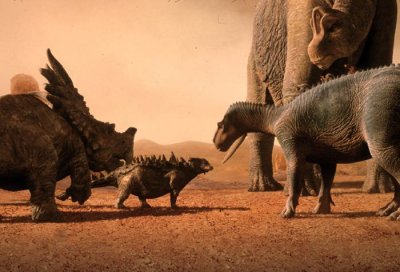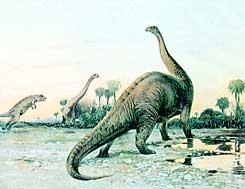Low oxygen levels may have caused two mass extinctions hundreds of millions of years ago that allowed dinosaurs to outshine mammalian ancestors and rule the roost, US researchers say

Low oxygen levels may have caused two mass extinctions hundreds of millions of years ago that allowed dinosaurs to overtake mammalian ancestors and rule the roost, US researchers said Friday.
Dinosaurs first appeared during a long period when oxygen levels in the atmosphere were low, and therefore developed particularly efficient breathing mechanisms. These allowed them to thrive in times when other species became extinct.
The researchers arrived at this theory by linking what is known about the physiology of the dinosaurs with new geological evidence, which suggests that in the period between 275 million years ago and 175 million years ago, oxygen levels were very low, about the same as the oxygen levels that can be found today at altitudes of 14,000 Foot.
Peter Ward, a paleontologist (researcher of fossils) from the University of Washington, said that he believes that low oxygen levels and hot greenhouse conditions, caused by increased volcanic activity, may have caused mass extinctions about 250 million years ago at the border between the Permian and Triassic periods, and about 200 years ago million years at the border between the Triassic and Jurassic periods.
The Permian-Triassic extinction is believed to have wiped out 90 percent of the species on Earth, including most of the proto-mammalian species, the direct ancestors of mammals.
The Triassic-Jurassic extinction wiped out more than half the species on Earth, including many species of mammals and mammal-like reptiles. The dinosaurs, however, thrived.
Ward said he put together three pieces of the puzzle - the birds' exceptionally efficient respiratory system, the findings, which indicated that dinosaur physiology was very similar, and a report, published earlier this year, showing that oxygen levels were low during both extinctions.
"Someone told me that he had seen or heard of geese flying over Mount Everest at 31,000 feet," said Ward, who will present his findings next week at a meeting of the Geological Society of America.
"If you put a man at 30,000 feet, he will be absolutely, in any respect - dead. The birds, on the other hand, are not only able to live there, they perform vigorous activity." Ward says.
Birds and dinosaurs have holes in their bones. Many of the large dinosaurs, such as the Brontosaurus or the Apatosaurus, probably had lungs, which were connected to a series of air sacs, which may have been used as a kind of bellows to move air through the body.
"The reason birds developed these systems is that they evolved from dinosaurs about halfway through the Jurassic period. They are the remains of the dinosaurs." Ward said.
"The professional literature has always said that the reason birds have air sacs is so they can breathe when they fly. I haven't heard of a flying brontosaurus," he added.
"On the other hand, if we take into account that birds fly at heights where the oxygen levels are significantly lower, we finally connect this with the fact that the oxygen levels on the ground were only about 10 or 11 percent when the dinosaurs evolved."
Today at sea level the oxygen levels in the atmosphere are about 21 percent.
If the dinosaurs had to breathe in environments where the atmospheric pressure was low, such efficient breathing systems gave them a survival advantage.
"You're really going to be favored in a bad, mean, low-oxygen environment," Ward said.
Dinosaurs ruled the world for many tens of millions of years, and their time passed only about 65 million years ago. Most scientists agree that the catalyst for the extinction was a meteor or asteroid impact.
The dinosaurs took over the world thanks to their ability to live in thin air
200 million years ago there was a mass extinction of creatures, but the dinosaurs only got stronger. A new theory claims that the cause of this is their adaptation to the thin oxygen that was then in the atmosphere
2.12.2003
From: Economist, Haaretz, Walla News!

There is no debate among researchers about the cause of the disappearance of the dinosaurs from the face of the earth 65 million years ago. The discovery of soil layers rich in iridium in many parts of the world raised the hypothesis about twenty years ago that a large asteroid hit the earth and caused the extinction of many species of animals, including the dinosaurs.
The discovery of a large crater in southern Mexico, whose age corresponds to the age of the soil layers rich in iridium, indicated about ten years ago the place where the fatal asteroid hit. However, not all scientists agree that this is indeed the place of impact. At the annual meeting of the Geological Society of America (GSA), held in early November, evidence was presented that the asteroid impact in southern Mexico occurred about 300,000 years before the end of the Cretaceous era. According to the hypothesis based on this evidence, the crater caused by the impact of the asteroid that wiped out the dinosaurs has not yet been discovered.
The scientists who presented the new evidence were attacked at the conference by other researchers, and it seems that this controversy is far from being resolved. But an equally fascinating question is, how did the dinosaurs become the rulers of the earth in the first place? The answer may be related to another mass extinction, which happened about 202 million years ago, at the end of the Triassic era.
Dinosaurs with the breathing mechanism of birds
The Triassic era was the first era of reptiles. The dinosaurs existed then, but made up a small part of the animal world. However, at the end of the age, when the other reptiles became extinct, the dinosaurs rose and prospered. Dr. Peter Ward from the University of Washington in Seattle offered an explanation for this during the conference.
Dr. Ward's explanation is based on the research work of Robert Brenner from Yale University. Four years ago, Brenner estimated the degree of change in the amount of oxygen in the atmosphere over the past 600 million years. According to his model, the oxygen level reached a peak of about 35% of the atmosphere about 300 million years ago, and in the following 75 million years it dropped sharply and reached less than half of this rate. The oxygen level remained low for 50 million years, then rose to 21% of the atmosphere, as it is today. This means that for a long period of time in Earth's history the air was as thin and difficult to breathe as the air found today at the top of a high mountain.
This fact in itself was not enough to cause a mass extinction, but it may have been the first stage of the extinction. According to Ward's theory, the volcanic eruptions that marked the end of the Triassic era filled the atmosphere with greenhouse gases such as carbon dioxide. According to the hypothesis, this caused an increase in temperatures. The warming hurt the animals, who had trouble functioning anyway due to the oxygen-poor air. In such a situation animals with efficient breathing mechanisms had a decisive advantage.
Dinosaurs seem to have had such a mechanism. Like their avian descendants, many dinosaurs had hollow bones and it is likely that the cavities contained air sacs. Ward speculates that the breathing mechanism of the dinosaurs was similar to that of the birds. In such a breathing mechanism, the air passes through the lungs twice: on its way in, it passes from the lungs to the air sacs, and from there it is returned to the lungs before being expelled. In this way, the utilization of oxygen is higher than in other breathing mechanisms (in humans, for example, the air is drawn in, stays in the lungs and is expelled, and some of the oxygen in it is not used at all). Ward hypothesizes that the special respiratory mechanism is the factor that gave the dinosaurs an advantage that allowed them to survive in the conditions that prevailed at the end of the Triassic era, and to thrive thereafter.
A rare dinosaur skeleton was stolen from a museum near Sydney
27.7.2003
Thieves broke into a museum near Sydney yesterday and stole a fossilized skeleton of a 110-million-year-old "Nancy" dinosaur, of which there are only five others in the world. The dinosaur skeleton was the evolutionary link between today's birds and "the familiar giant dinosaurs of the Tyrannosaurus type," explained Gavin Fry, director of the Newcastle Regional Museum, from which the skeleton was stolen.
The Pacitosaurus mongolinensis dinosaur, which is about 60 cm high and 90 cm long, was loaned to Australia by the Natural History Museum in Beijing to present it in an exhibition describing the evolutionary development of birds from dinosaurs. The thieves managed to elude the police and the museum guards, climb over a fence more than two meters high, enter the museum through an armored glass window and remove the skeleton within five minutes.
